In the 2015 Apple Watch 1st gen, imagining features like those in the 2023 Apple Watch Ultra 2 would have been challenging. Back then, they were smartwatches with basic health tracking and connectivity functions. But each year, Apple kept adding more and more capabilities.
By 2016, the Series 1 and 2 had become faster and had acquired GPS and water resistance. The Series 3, launched in 2017, was the first to feature its cellular connection, allowing it to work independently from the iPhone.
The Series 4, released in 2018, impressed everyone with its larger screen and ECG function – it could now alert users to serious heart issues. In 2019, the Series 5 introduced the always-on display.
In 2020, Apple introduced the more affordable Apple Watch SE and the Series 6, which could measure blood oxygen levels.
The Apple Watch Ultra 1, released in 2022, took a significant leap forward. They were specially designed for extreme environments and active rest. Then, in 2023, Apple enhanced the Series 8 and 9 with superior health tracking, while the Ultra 2 received upgrades in durability and battery life, catering to outdoor enthusiasts.
Apple Watch 1st gen 2015
The original Apple Watch, released in April 2015, marked a new venture for Apple. It quickly became the best-selling wearable device, with 4.2 million units sold in the second quarter of 2015.
Apple’s design chief at the time, Jony Ive, was interested in building a watch. The project was Apple’s first major new product without Steve Jobs’ input.
The first Apple Watch came in three variants: Sport, Watch, and Edition. It was available in two case sizes, 38mm and 42mm, to cater to different wrist sizes. The cases were made from sturdy stainless steel, available in a classic look or a sleek black variant.

The display deserved special attention, equipped with a crisp Retina display featuring Force Touch technology. It was protected by Ion-X glass in the Sport version and more robust sapphire crystal in the standard and Edition models. Apple S1 processor, with an additional 512MB of RAM for smooth operation. With 8 GB of storage, there was ample space for apps and data.
The watch offered up to 18 hours of battery life, and its IPX7 rating made it splash-resistant, although it was not suitable for full submersion in water. A key feature was the inclusion of Wi-Fi and Bluetooth 4.0.
Functionalities included a digital crown, touch gestures like tap and swipe, Force Touch, and a side button. The watch also came equipped with a heart rate sensor and was designed to integrate seamlessly with iOS.
Apple Watch Series 1 and 2 Series 2016
In September 2016, Apple introduced two new models: the Apple Watch Series 1 and Series 2.
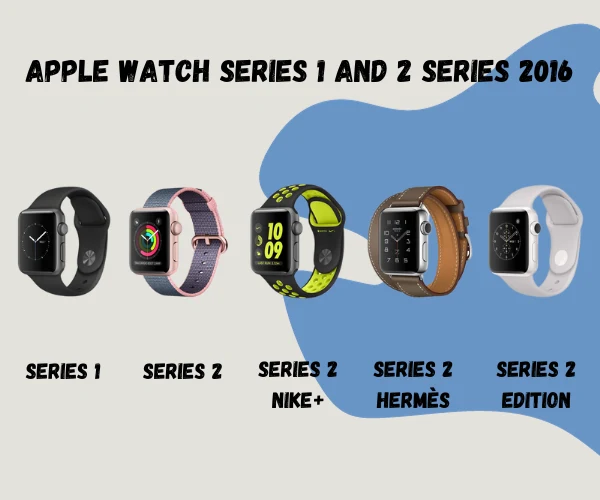
Apple Watch Series 1 was essentially an upgraded version of the original Apple Watch. It retained many original features but came with a significant performance boost. This improvement was due to a new dual-core processor, making the Series 1 up to 50% faster than its predecessor. Series 1 was available only in an aluminum case.
Apple Watch Series 2, on the other hand, marked a more significant step forward in terms of functionality and design. It was available in lightweight aluminum or stainless steel cases with various band colors. The Series 2 was notable for being swim-proof up to 50 meters. It also introduced a built-in GPS, enabling users to track their workouts more accurately without carrying their iPhones. The Series 2’s performance was enhanced by the new S2 chip, which featured a dual-core processor and an improved GPU. The display was also brighter, making it read in direct sunlight easier.
Apple also introduced new watch faces with watchOS 3, including the Minnie Mouse, Activity, and Numerals faces.
A notable addition to the Series 2 lineup was the Apple Watch Nike+ model, starting at $369 and featuring an aluminum case with a Nike sport band designed specifically for runners. Furthermore, Apple continued collaborating with Hermès for the Series 2, offering unique Hermès versions starting at $1,149. These models featured a stainless steel case and exclusive Hermès bands. Apple also revamped the luxury Edition line with a new ceramic Apple Watch Edition.
Apple Watch Series 3 2017
The Apple Watch Series 3, released in 2017, was a big step up from earlier models because it could do much more independently without needing an iPhone nearby. This was mainly because it had cellular connectivity, meaning it could make calls, send texts, and stream music.

It looked similar to the older models but came in new colors and bands. You could choose from different sizes (38mm or 42mm) and materials like aluminum or stainless steel. There was also a ceramic version. Plus, there were unique versions for runners (Nike+) and high-end fashion models (Hermès) with unique bands and features.
Technically, the Series 3 was quite powerful. It had a fast processor and a wireless chip for better performance and connection. The screen was bright and clear, which was great for outdoor use. It could connect to both LTE and UMTS networks for cellular models, and all models had Wi-Fi and Bluetooth.
This watch was also great for fitness and health. It had a heart rate monitor and new features for tracking different workouts, like swimming or high-intensity training. Apple also ensured the watch was environmentally friendly, with energy-saving features and safe materials.
Apple Watch Series 4 2018
The Apple Watch Series 4, launched in 2018, was a big update from the previous models. It came with a larger display, about 30% bigger than the Series 3. This allowed for more detailed and colorful complications on the screen. The watch’s design was also refreshed, featuring a more tactile and innovative digital crown.

One of the standout features of the Series 4 was the introduction of an electrocardiogram (ECG) function. Users could check their heart’s status in more detail than just pulse monitoring. The ECG function worked by touching the Digital Crown while wearing the watch, and after 30 seconds, it gave a reading that could detect issues like atrial fibrillation.
Besides heart monitoring, the Series 4 also had a new fall detection feature. It used advanced sensors and algorithms to detect hard falls. If a fall was detected and the user didn’t respond in a minute, the watch could automatically call emergency services and send a message with the user’s location to emergency contacts.
Despite the added features, the battery life was about 18 hours, similar to the Series 3. The Apple Watch Series 4 was available in three colors and two sizes (40mm and 44mm). It maintained the same 16 GB storage capacity as the Series 3, which was enough for some music storage and apps.
Apple Watch Series 5 2019
The Apple Watch Series 5, introduced in 2019, brought noteworthy changes and improvements over its predecessors. A significant highlight of this model was the introduction of an Always-On Retina display. This feature meant that users could glance at their watch for time or other information without gesturing or tapping the screen.
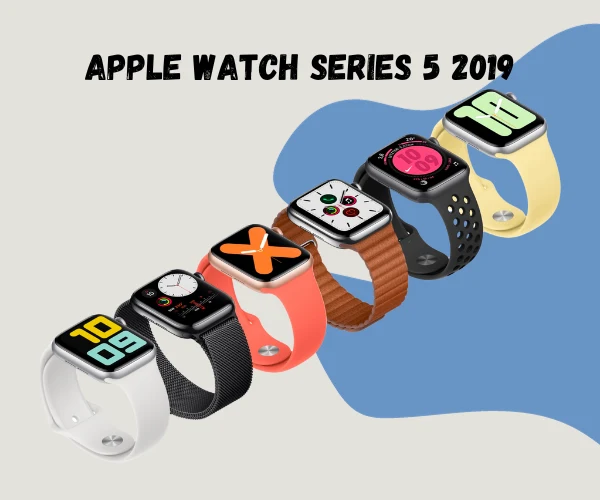
Another significant upgrade was the increase in storage capacity to 32GB. This expansion was beneficial with the advent of watchOS 6, which included a separate App Store for the Apple Watch, enabling the device to operate more independently from the iPhone.
Apple also introduced new materials for the Series 5 case. The watch was now available in a titanium option. The titanium model was offered in two finishes: natural brushed and space black titanium with a diamond-like coating.
Apple Watch SE 2020
The Apple Watch SE, released in 2020, offers a more affordable option without compromising features and performance. It shared a similar design to the Series 5 and 6, with the larger, modern screen introduced in Series 4. Available in both 40mm and 44mm sizes, the SE was offered in aluminum finishes of gold, space grey, or silver.
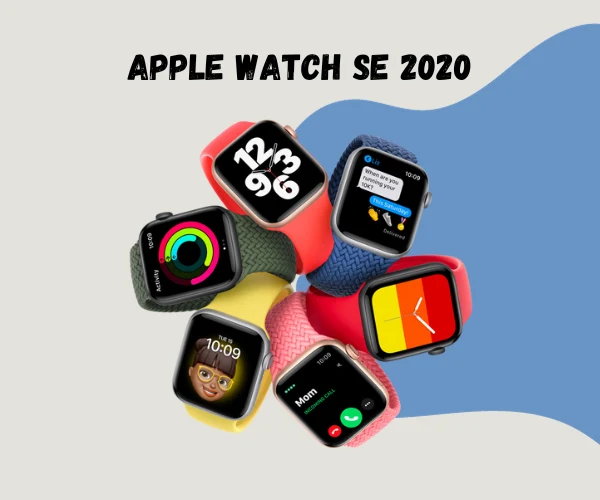
Performance-wise, the Watch SE was powered by the same S5 processor found in the Series 5, providing a swift and responsive experience. It was noticeably faster than the Series 3, especially when using more complex apps. However, unlike the Series 6, it lacked an always-on display, reverting to a screen that only activates when raised or tapped.
The Apple Watch SE offers 32GB of storage, which is ample space for music and media.
Health and fitness features were a strong point for the Watch SE. While it missed out on the ECG and SpO2 sensors in more premium models, it still had robust fitness tracking features. This included the three activity rings for monitoring daily physical activity, built-in GPS for outdoor activities, and a comprehensive Workout app supporting various exercise types. The heart rate monitor was also present, providing vital health data.
Sleep tracking was another feature of the Watch SE, although it wasn’t as detailed as some of its competitors. It focused more on sleep consistency and duration rather than providing in-depth sleep stage analysis.
Apple Watch Series 6 2020
The Apple Watch Series 6 was released in 2020. This model was notable for introducing a blood oxygen sensor, offering users a deeper insight into their overall wellness. It also came with an always-on altimeter and a more colorful lineup. It features new finishes like blue and (PRODUCT)RED in aluminum, gold, graphite, and silver in stainless steel, and titanium in titanium and space black.
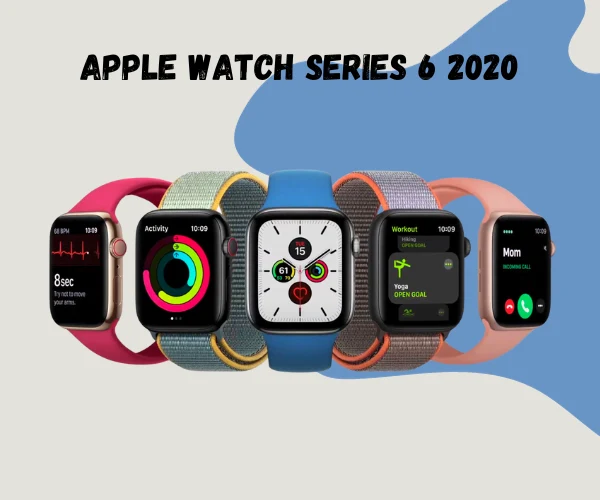
The Series 6 maintained the exact display sizes as its predecessor (40mm and 44mm) but boasted an Always-On Retina LTPO OLED display, which was exceptionally bright at 1000 nits. The watch also included the U1 chip for Ultra Wideband support.
Regarding connectivity, the Series 6 supported LTE, UMTS, Wi-Fi (2.4GHz and 5GHz), and Bluetooth 5.0. The watch offered an electrical heart sensor (with the ECG app), a third-generation optical heart sensor, GPS/GNSS, and water resistance up to 50 meters. It also continued to support Apple Pay and GymKit.
The watch’s battery life was up to 18 hours, consistent with previous models, despite adding new features. The Series 6 was available in GPS and GPS + Cellular models, with the cellular models allowing for international emergency calling and Emergency SOS.
Apple’s watchOS 7 brought several new features to the Series 6, including seven new watch face options (like Chronograph Pro and GMT), new health and fitness features (like low-range VO2 Max and sleep tracking), and automatic handwashing detection.
Apple Watch Series 7 2021
One of the most significant changes was the display. The Series 7 featured the most significant screen on an Apple Watch, with a 20% larger screen area than the Series 6. The borders around the screen were significantly reduced (about 40% compared to the Series 6), providing a more expansive viewing area. This change resulted in an Always-On Retina display that was 70% brighter indoors, making checking the time or notifications easier without moving your wrist.

Regarding durability, the Series 7 boasted a new crack-resistant front crystal, making it more resilient against damage. It was also the first Apple Watch with an IP6X certification for resistance to dust and maintaining a WR50 water resistance rating.
The battery life of the Series 7 remained at an estimated 18 hours, similar to previous models. However, it featured a 33% faster charging capability, which allowed it to charge to 80% in just about 45 minutes.
A notable improvement in user interface came with the addition of a full QWERTY keyboard, a first for the Apple Watch. Combined with on-device machine learning, this feature was designed to make text input on the small screen more convenient and accurate.
The Series 7 was available in new aluminum case colors: midnight, starlight, green, a new blue, and (PRODUCT)RED. It also continued to be compatible with a wide range of bands.
Apple Watch SE 2 2022
The Apple Watch SE 2, released in 2022, continued Apple’s trend of offering a more budget-friendly option in its smartwatch lineup. It featured robust features, including GPS, an always-on altimeter, water resistance up to 50 meters, and a second-generation optical heart sensor. The watch also supported international emergency calling, SOS, and fall and crash detection capabilities.
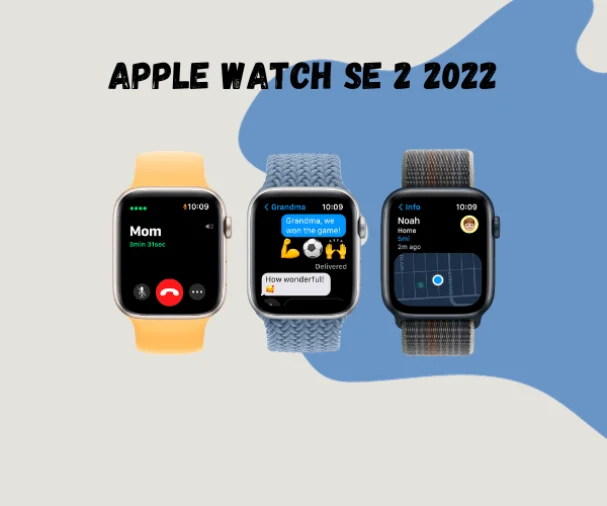
With a Retina LTPO OLED display, it provided clear visuals, and the device was powered by an S8 SiP with a 64-bit dual-core processor, making it quite capable of daily tasks. It offered LTE and UMTS for GPS + Cellular models, Wi-Fi 4, and Bluetooth 5.3 for connectivity. The Apple Watch SE 2 maintained an 18-hour battery life, similar to its predecessors.
Environmentally, the watch featured 100% recycled aluminum in its case and other eco-friendly materials. It was available in three colors: Midnight, Starlight, and Silver. The watch came in two sizes, 40mm and 44mm.
Apple Watch Ultra 1 2022
This model was distinctively different from its predecessors in design and build. It featured a large 49mm size, which was noticeably more significant than the other Apple Watches, and was crafted to cater to a more rugged usage style. The display was clear and well-suited for various lighting conditions, and the watch introduced a new ‘Action’ button for quick access to certain features.
Apple Watch Ultra was designed for different sports: Alpine Loop, Trail Loop, and Ocean Band.
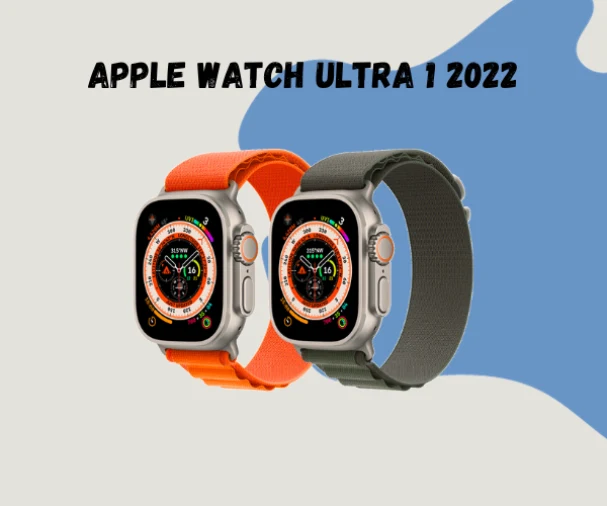
In terms of durability, the Apple Watch Ultra set new standards. It was water-resistant up to 100 meters and was suitable for recreational diving up to 40 meters. The Ocean Band, specifically designed for water sports, complemented this feature. The watch was IP6X dust resistant and met the MIL-STD 810H standard, a military-grade certification indicating its robustness in challenging environments.
It came equipped with blood oxygen sensors, an ECG app, and new temperature sensors. These features were particularly beneficial for women’s health, as the temperature sensing could be used with the watch’s Cycle Tracking feature. The watch also offered various new workout features, including metrics to enhance running performance.
It supported cellular connectivity, allowing users to call and receive messages without Wi-Fi. Moreover, it boasted an impressive battery life of 36 hours, extendable to 60 hours in low-power mode.
Apple Watch Series 8 2023
This series came in 41mm and 45mm sizes and offered various case finishes and colors. The aluminum case colors included starlight, midnight, silver, and (PRODUCT)RED, while the stainless steel cases were available in silver, graphite, and gold.

The Series 8 was equipped with an S8 SiP with a 64-bit dual-core processor, the W3 Apple wireless chip, and a U1 chip for Ultra Wideband. It supported LTE, UMTS for GPS + Cellular models, Wi-Fi (2.4GHz and 5GHz), and Bluetooth 5.3 for connectivity.
It featured a high dynamic range gyroscope, an ambient light sensor, a speaker, a microphone, and Apple Pay and GymKit support. With a capacity of 32GB, the watch provided ample storage for apps and data.
The display of the Series 8 was an Always-On Retina LTPO OLED display, bright up to 1000 nits, ensuring clear visibility in various lighting conditions. For power, it used a built-in rechargeable lithium-ion battery, offering up to 18 hours of usage. The watch also came with a USB-C magnetic fast charging cable.
The Series 8 embraced sustainability with 100% recycled aluminum in the case, tungsten in the Taptic Engine, rare earth elements in all magnets, and tin in the SiP. It also used arsenic-free display glass and was free from mercury, BFR, PVC, and beryllium.
Apple Watch Series 9 2023
This model maintained the recognizable rectangular design of its predecessors, available in two sizes, 41mm and 45mm. Customers could choose between aluminum and stainless steel for the case material. The Series 9 introduced a new pink color to its range, matching the iPhone 15 colors of that year, along with other standard options like Starlight, Midnight, Silver, and Product (RED).
A notable advancement in the Series 9 was its display, which received a significant brightness upgrade, reaching up to 2,000 units, double that of the Series 8.
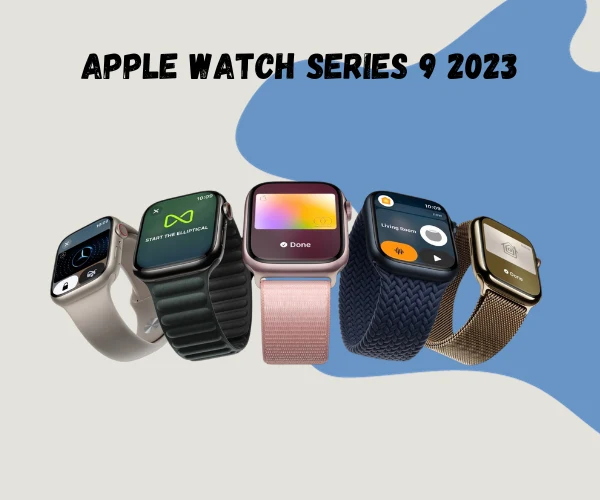
The Series 9 has the new S9 SiP (System in Package), which marked a notable performance boost. The dual-core CPU had 60% more transistors, and the GPU was 30% faster than previous models. The inclusion of a four-core neural engine allowed for faster data processing. The Series 9 also saw an increase in internal storage to 64GB.
The watch also introduced new environmentally friendly watch bands. To move towards sustainability, Apple replaced leather bands with the new FineWoven material, which contains 68% post-consumer recycled content. The Series 9, when paired with a new Sport Loop band, was celebrated as Apple’s first utterly carbon-neutral product.
Despite these upgrades, the Series 9’s battery life remained the same as that of previous models, offering up to 18 hours of use. However, a new Low Power Mode was introduced, potentially extending the battery life to 36 hours.
Apple Watch Ultra 2 2023
The Apple Watch Ultra 2, introduced in 2023, is a significant upgrade. It features a robust 49mm case made of aerospace-grade titanium, making it both sturdy and lightweight at 61.4 grams. This watch is designed to endure various environments, from high altitudes to extreme temperatures.
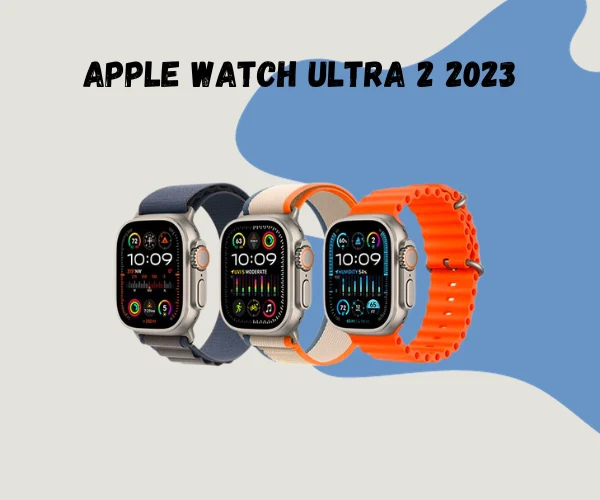
One of the notable enhancements in the Ultra 2 is the S9 SiP chip, which includes a 64-bit dual-core processor and a 4-core Apple Neural Engine. This powerful chipset provides smooth performance and efficient processing, and the watch comes with a generous 64GB of internal storage.
For health and fitness enthusiasts, the Ultra 2 is equipped with an array of sensors, including a blood oxygen sensor, a third-generation optical heart sensor, and an electrical heart sensor capable of ECG readings. It also includes temperature sensing, a high-g accelerometer, and a high dynamic range gyroscope.
The display is an Always-On Retina LTPO OLED screen protected by flat sapphire crystal. It boasts a maximum brightness of 3000 nits, making it easily readable even under harsh sunlight. The watch is water-resistant up to 100 meters and dust-resistant with an IP6X rating, suitable for recreational scuba diving up to 40 meters.
Regarding connectivity, the Ultra 2 supports Precision dual-frequency GPS, combining L1 and L5 for accurate distance, pace, and route calculations. It also features LTE, UMTS, Wi-Fi, and Bluetooth 5.3 connectivity alongside the second-generation Ultra Wideband chip.
The watch runs on watchOS 10, which introduces redesigned apps, new watch faces, and features like Night Mode that activates automatically in the dark. It also enhances cyclists’ capabilities, including Bluetooth connectivity for power meters and speed sensors. The updated Compass app and new topographic maps in the Maps app make navigation more accessible and detailed.
The Ultra 2 includes Emergency SOS, international emergency calling, a siren, Crash Detection, and Fall Detection for safety. The battery life offers up to 36 hours of everyday use and 72 hours in Low Power Mode, with USB-C magnetic fast charging capability.





